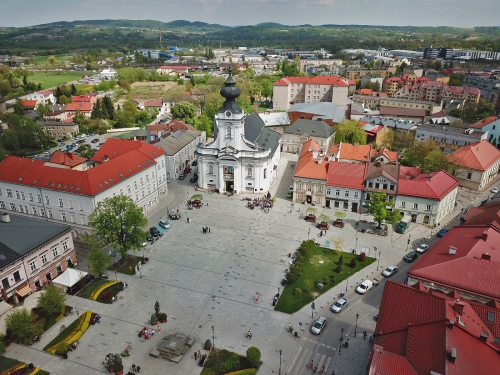The spatial arrangement of the Wadowice Market Square was initially shaped in the late Middle Ages. In the 16th century, the town was extended along the north-south axis. After the First Partition of Poland (1772) and the establishment of Galicia, the spatial arrangement of the town was markedly transformed. The Vienna-Lviv trunk road was built through the central point of Wadowice. From that moment onwards, the town developed along the main road from the west towards the east. At that time, work was begun to improve the appearance and functionality of the Market Square. The ditch that divided the square into two parts was backfilled, and in the early 19th century the graveyard surrounding the parish church was removed. The spatial arrangement of the Market Square was also affected by the last great fire in the town in ca. 1818/19. As a result of this, the eastern frontage was completely destroyed. Then the square space in the shape of an equilateral quadrilateral ceased to exist. The Market Place was ‘opened’ towards the church and so it has remained ever since. Every Thursday in Galician times, Wadowice transformed itself into a huge fair. Crowds of traders occupied nearly all the streets diverging from the Market Square. The central square in town was also the main point of trade. In the 19th century, it was commonly believed that you could buy and sell basically everything at the fair. Therefore, alongside the sumptuous stalls and the overfilled carts of the wealthy traders and artisans at the Wadowice fair, there were also small no-frills stalls run by petty retailers offering junk.
Church of the Presentationof the Blessed Virgin Mary in Wadowice
Among the most important public buildings in 19th century Wadowice were sacral buildings. The first mentions of a parish church in the town date as far back as the 14th century. In the mid-18th century, the original wooden structure of the sanctuary was replaced with a brick construction, which was later on extended. In the late 19th century the church façade was remodelled together with the clock tower according the design of the Cracow-based architect Tomasz Pryliński. At that time, the façade was adorned with figures of saints by Zygmunt Langman. They represent the Mother of God with St Adalbert and St Stanislaus, the patron saints of Poland.
Municipal Office building
The prestigious character of the town and its demographic development motivated the authorities to adapt their seat to the new circumstances. On the northern side of the Market Place, to the left of the church, the building of the Magistrate’s Office was constructed in 1846 and replaced the worn-out wooden Town Hall. Initially, also the County Court, the Gymnasium and the main state school had their seats here. The distinguished Mayors of the town that are worth mentioning include Tadeusz Starzewski (1860-1931), Doctor of Law and member of the Department of the County Savings Fund, and Franciszek Opydo (1856-1923), a physician and a deputy to the State Council in Vienna.

